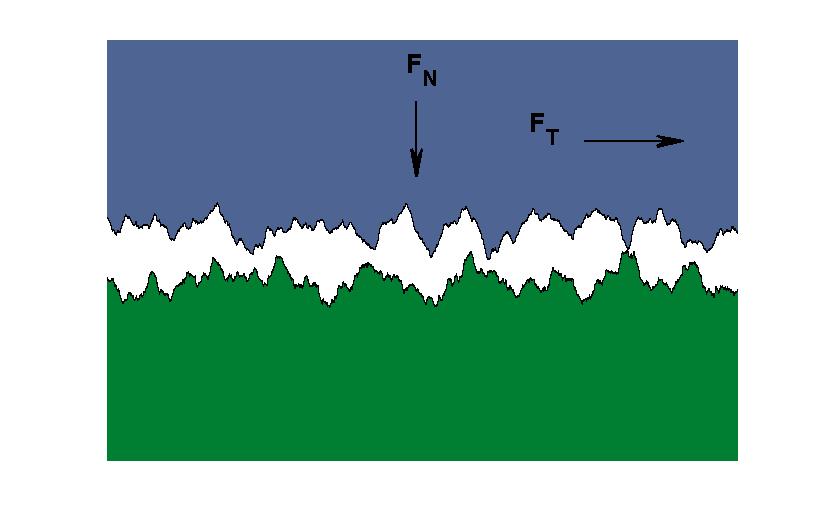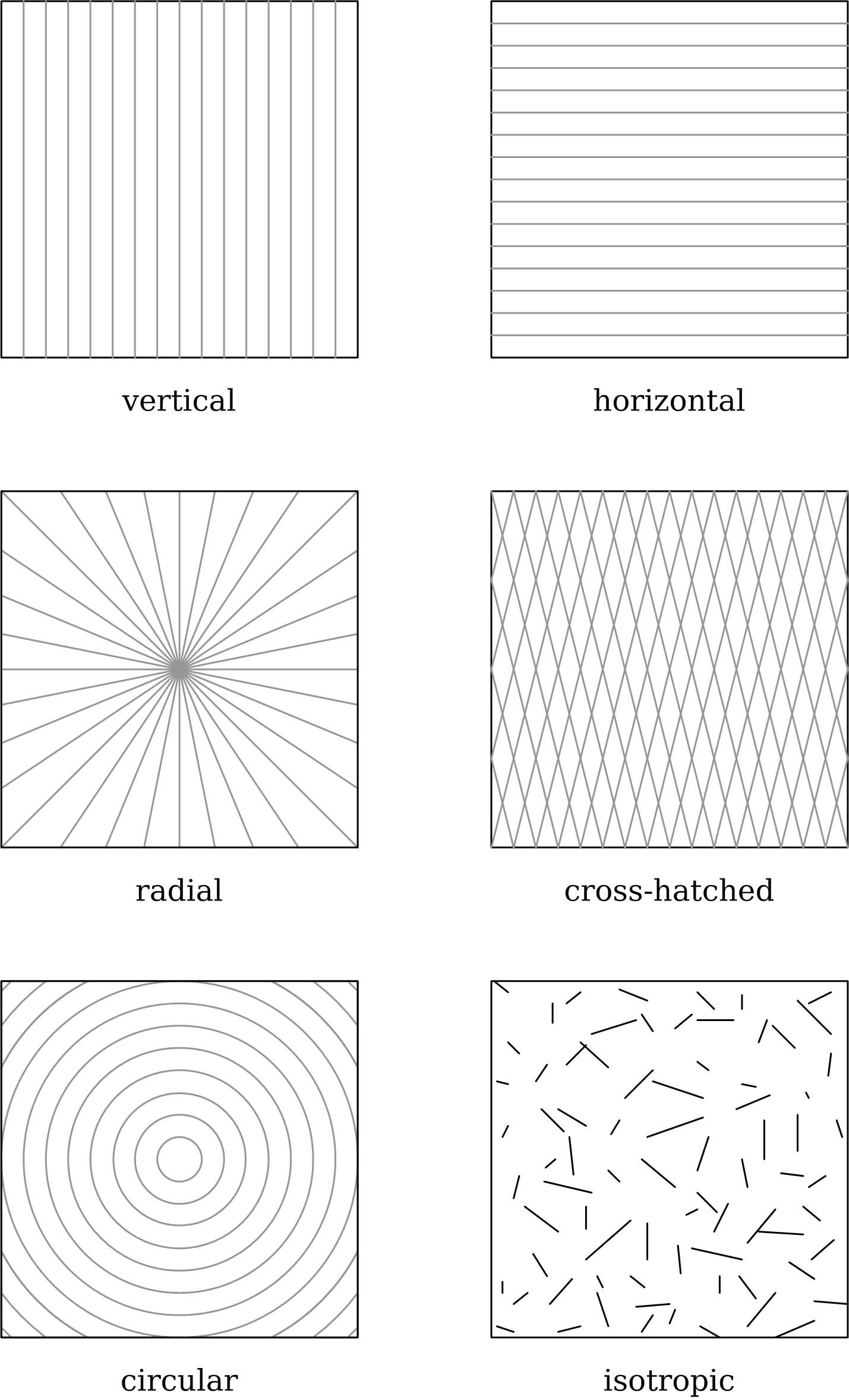|
Normal Contact Stiffness
Normal contact stiffness is a physical quantity related to the generalized force displacement behavior of rough surfaces in contact with a rigid body or a second similar rough surface. Rough surfaces can be seen as consisting of large numbers of asperities. As two solid bodies of the same material approach one another, the asperities interact, and they transition from conditions of non-contact to homogeneous bulk behaviour. The varying values of stiffness and true contact area that is exhibited at an interface during this transition are dependent on the conditions of applied pressure and are of importance for the study of systems involving the physical interactions of multiple bodies including granular matter, electrode contacts, and thermal contacts, where the interface-localized structures govern overall system performance. [...More Info...] [...Related Items...] OR: [Wikipedia] [Google] [Baidu] |
Surface Roughness
Surface roughness, often shortened to roughness, is a component of surface finish (surface texture). It is quantified by the deviations in the direction of the normal vector of a real surface from its ideal form. If these deviations are large, the surface is rough; if they are small, the surface is smooth. In surface metrology, roughness is typically considered to be the high-frequency, short-wavelength component of a measured surface. However, in practice it is often necessary to know both the amplitude and frequency to ensure that a surface is fit for a purpose. Roughness plays an important role in determining how a real object will interact with its environment. In tribology, rough surfaces usually wear more quickly and have higher friction coefficients than smooth surfaces. Roughness is often a good predictor of the performance of a mechanical component, since irregularities on the surface may form nucleation sites for cracks or corrosion. On the other hand, roughness may pr ... [...More Info...] [...Related Items...] OR: [Wikipedia] [Google] [Baidu] |
Rigid Body
In physics, a rigid body (also known as a rigid object) is a solid body in which deformation is zero or so small it can be neglected. The distance between any two given points on a rigid body remains constant in time regardless of external forces or moments exerted on it. A rigid body is usually considered as a continuous distribution of mass. In the study of special relativity, a perfectly rigid body does not exist; and objects can only be assumed to be rigid if they are not moving near the speed of light. In quantum mechanics, a rigid body is usually thought of as a collection of point masses. For instance, molecules (consisting of the point masses: electrons and nuclei) are often seen as rigid bodies (see classification of molecules as rigid rotors). Kinematics Linear and angular position The position of a rigid body is the position of all the particles of which it is composed. To simplify the description of this position, we exploit the property that the body is rigi ... [...More Info...] [...Related Items...] OR: [Wikipedia] [Google] [Baidu] |
Asperity (materials Science)
In materials science, asperity, defined as "unevenness of surface, roughness, ruggedness" (from the Latin ''asper''—"rough"), has implications (for example) in physics and seismology. Smooth surfaces, even those polished to a mirror finish, are not truly smooth on a microscopic scale. They are rough, with sharp, rough or rugged projections, termed "asperities". Surface asperities exist across multiple scales, often in a self affine or fractal geometry. The fractal dimension of these structures has been correlated with the contact mechanics exhibited at an interface in terms of friction and contact stiffness. When two macroscopically smooth surfaces come into contact, initially they only touch at a few of these asperity points. These cover only a very small portion of the surface area. Friction and wear originate at these points, and thus understanding their behavior becomes important when studying materials in contact. When the surfaces are subjected to a compressive load, t ... [...More Info...] [...Related Items...] OR: [Wikipedia] [Google] [Baidu] |
Granular Matter
A granular material is a conglomeration of discrete solid, macroscopic particles characterized by a loss of energy whenever the particles interact (the most common example would be friction when grains collide). The constituents that compose granular material are large enough such that they are not subject to thermal motion fluctuations. Thus, the lower size limit for grains in granular material is about 1 μm. On the upper size limit, the physics of granular materials may be applied to ice floes where the individual grains are icebergs and to asteroid belts of the Solar System with individual grains being asteroids. Some examples of granular materials are snow, nuts, coal, sand, rice, coffee, corn flakes, fertilizer, and bearing balls. Research into granular materials is thus directly applicable and goes back at least to Charles-Augustin de Coulomb, whose law of friction was originally stated for granular materials. Granular materials are commercially important in applic ... [...More Info...] [...Related Items...] OR: [Wikipedia] [Google] [Baidu] |
Electrode
An electrode is an electrical conductor used to make contact with a nonmetallic part of a circuit (e.g. a semiconductor, an electrolyte, a vacuum or air). Electrodes are essential parts of batteries that can consist of a variety of materials depending on the type of battery. The electrophore, invented by Johan Wilcke, was an early version of an electrode used to study static electricity. Anode and cathode in electrochemical cells Electrodes are an essential part of any battery. The first electrochemical battery made was devised by Alessandro Volta and was aptly named the Voltaic cell. This battery consisted of a stack of copper and zinc electrodes separated by brine-soaked paper disks. Due to fluctuation in the voltage provided by the voltaic cell it wasn't very practical. The first practical battery was invented in 1839 and named the Daniell cell after John Frederic Daniell. Still making use of the zinc–copper electrode combination. Since then many more batteries have be ... [...More Info...] [...Related Items...] OR: [Wikipedia] [Google] [Baidu] |
Thermal Contact
In heat transfer and thermodynamics, a thermodynamic system is said to be in thermal contact with another system if it can exchange energy through the process of heat. Perfect thermal isolation is an idealization as real systems are always in thermal contact with their environment to some extent. When two solid bodies are in contact, a resistance to heat transfer exists between the bodies. The study of heat conduction between such bodies is called thermal contact conductance (or thermal contact resistance). References See also *Thermal equilibrium - When two objects A and B are in thermal contact and there is no net transfer of thermal energy from A to B or from B to A, they are said to be in thermal equilibrium. The majority of objects experiencing thermal equilibrium still do exchange thermal energy but do so equally so that the net heat transfer is zero. * Perfect thermal contact *Zeroth law of thermodynamics The zeroth law of thermodynamics is one of the four principal law ... [...More Info...] [...Related Items...] OR: [Wikipedia] [Google] [Baidu] |
Surface Finish
Surface finish, also known as surface texture or surface topography, is the nature of a surface as defined by the three characteristics of lay, surface roughness, and waviness.. It comprises the small, local deviations of a surface from the perfectly flat ideal (a true plane). Surface texture is one of the important factors that control friction and transfer layer formation during sliding. Considerable efforts have been made to study the influence of surface texture on friction and wear during sliding conditions. Surface textures can be isotropic or anisotropic. Sometimes, stick-slip friction phenomena can be observed during sliding, depending on surface texture. Each manufacturing process (such as the many kinds of machining) produces a surface texture. The process is usually optimized to ensure that the resulting texture is usable. If necessary, an additional process will be added to modify the initial texture. The latter process may be grinding (abrasive cutting), polishing, ... [...More Info...] [...Related Items...] OR: [Wikipedia] [Google] [Baidu] |
Fractal Dimension
In mathematics, more specifically in fractal geometry, a fractal dimension is a ratio providing a statistical index of complexity comparing how detail in a pattern (strictly speaking, a fractal pattern) changes with the scale at which it is measured. It has also been characterized as a measure of the space-filling capacity of a pattern that tells how a fractal scales differently from the space it is embedded in; a fractal dimension does not have to be an integer. The essential idea of "fractured" dimensions has a long history in mathematics, but the term itself was brought to the fore by Benoit Mandelbrot based on his 1967 paper on self-similarity in which he discussed ''fractional dimensions''. In that paper, Mandelbrot cited previous work by Lewis Fry Richardson describing the counter-intuitive notion that a coastline's measured length changes with the length of the measuring stick used ( see Fig. 1). In terms of that notion, the fractal dimension of a coastline quantifies ho ... [...More Info...] [...Related Items...] OR: [Wikipedia] [Google] [Baidu] |
Asperity (materials Science)
In materials science, asperity, defined as "unevenness of surface, roughness, ruggedness" (from the Latin ''asper''—"rough"), has implications (for example) in physics and seismology. Smooth surfaces, even those polished to a mirror finish, are not truly smooth on a microscopic scale. They are rough, with sharp, rough or rugged projections, termed "asperities". Surface asperities exist across multiple scales, often in a self affine or fractal geometry. The fractal dimension of these structures has been correlated with the contact mechanics exhibited at an interface in terms of friction and contact stiffness. When two macroscopically smooth surfaces come into contact, initially they only touch at a few of these asperity points. These cover only a very small portion of the surface area. Friction and wear originate at these points, and thus understanding their behavior becomes important when studying materials in contact. When the surfaces are subjected to a compressive load, t ... [...More Info...] [...Related Items...] OR: [Wikipedia] [Google] [Baidu] |
Surfaces
A surface, as the term is most generally used, is the outermost or uppermost layer of a physical object or space. Surface or surfaces may also refer to: Mathematics *Surface (mathematics), a generalization of a plane which needs not be flat *Surface (differential geometry), a differentiable two-dimensional manifold *Surface (topology), a two-dimensional manifold * Algebraic surface, an algebraic variety of dimension two *Coordinate surfaces *Fractal surface, generated using a stochastic algorithm *Polyhedral surface * Surface area *Surface integral Arts and entertainment * Surface (band), an American R&B and pop trio ** ''Surface'' (Surface album), 1986 *Surfaces (band), American musical duo * ''Surface'' (Circle album), 1998 * "Surface" (Aero Chord song), 2014 * ''Surface'' (2005 TV series), an American science fiction show, 2005–2006 * ''Surface'' (2022 TV series), an American psychological thriller miniseries that began streaming in 2022 *'' The Surface'', an American film, 2 ... [...More Info...] [...Related Items...] OR: [Wikipedia] [Google] [Baidu] |
Tribology
Tribology is the science and engineering of interacting surfaces in relative Motion (physics), motion. It includes the study and application of the principles of friction, lubrication and wear. Tribology is highly interdisciplinary, drawing on many academic fields, including physics, chemistry, materials science, mathematics, biology and engineering. People who work in the field of tribology are referred to as ''tribologists''. The fundamental objects of study in tribology are tribosystems, which are physical systems of contacting surfaces. In lubricated tribosystems, contact stress can create tribofilms. Subfields of tribology include biotribology, nanotribology, space tribology and tribotronics. Etymology The word ''tribology'' derives from the Ancient Greek, Greek root τριβ- of the verb , ''wiktionary:tribo-, tribo'', "I rub" in classic Greek, and the suffix ''-logy'' from , ''wiktionary:-logia, -logia'' "study of", "knowledge of". Peter Jost coined the word in 1966, in t ... [...More Info...] [...Related Items...] OR: [Wikipedia] [Google] [Baidu] |






